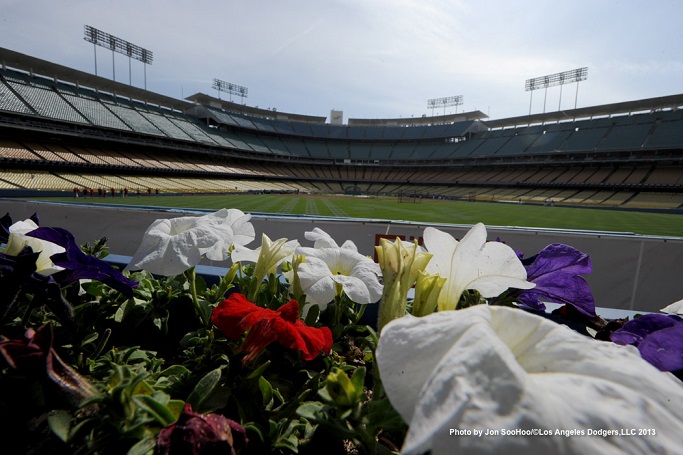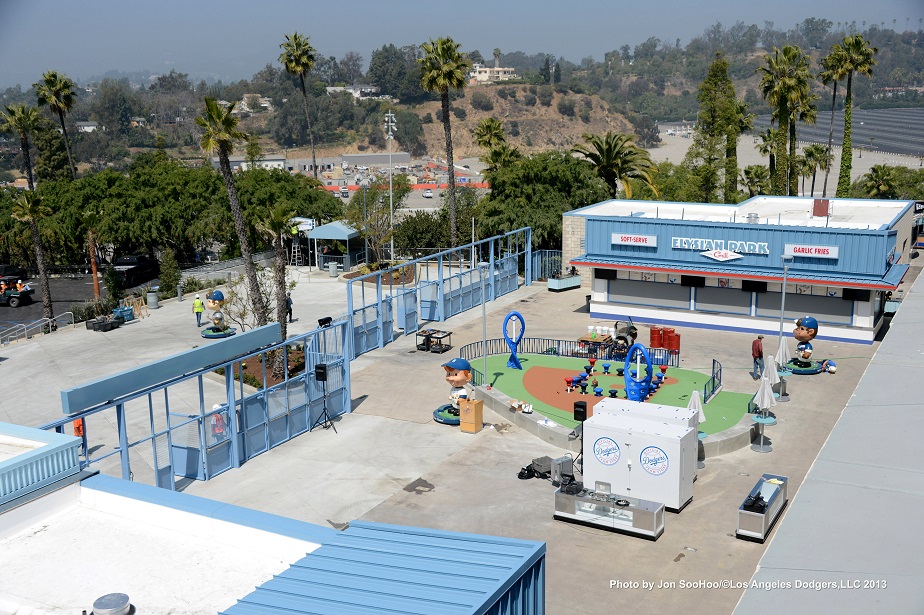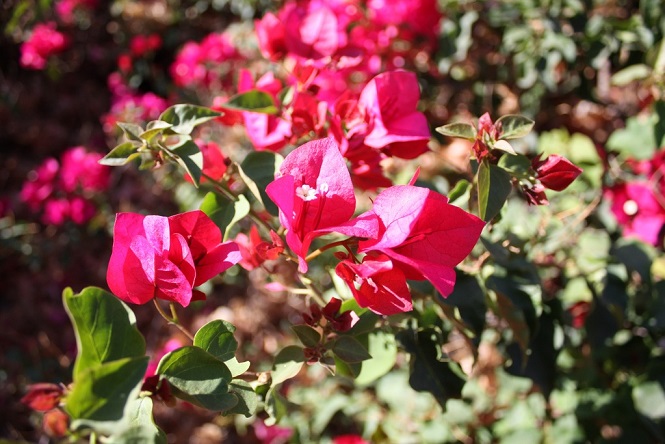Like many longtime Dodger fans, I am a huge history buff about our beloved Dodger franchise. In fact, if there is a history book related to the Dodgers, I have probably either already read it or it is on my list of books to read. I simply can’t get enough of this stuff.
Last week, my good friend Evan Bladh submitted a guest post here on ThinkBlueLA entitled Petunias in the Pavilion. Evan’s article was based on the fact that as part of the $100 million stadium renovations, planters were installed directly in front of the first rows of both the Left and Right Field Pavilions and petunias planted in them. Yes, petunias.

I admit that I was wrong about the Pavilion petunias, but not for the reason you might think.
(Photo credit – Jon SooHoo)
As you might expect, Evan’s article was taken seriously by most and not so serious by others, including myself. Being a die-hard old-school baseball traditionalist, I had no time for flowers or flower pots, at least not inside of the stadium and especially not directly in front of my longtime front row LFP seasons seats. I mean this is baseball we’re talking about here, not botany. The only horticulture I care about is grass and dirt with a little chalk mixed in. I would have much rather seen the money that was spent on the flowers (and what will undoubtedly be non-stop care and maintenance to pluck peanut shells, sunflower seed and other miscellaneous garbage out of the planters) on three or four additional urinals in the LFP men’s restroom, as four isn’t going to cut it – especially in the later innings when the “beer effect” kicks into high gear, if you get my drift.
But alas, I knew that I would be among the minority from those who would find the flowers “sooo cute”, so why fight it. I figure that they’ll never survive a month anyway amongst the unruly and uncontrollable bleacher creatures, or so our bad rap goes – this in spite of the fact that nearly half of those in the LFP these days are season ticket holders, many of whom with kids.
Needless to say I got the surprise of my life when I attended the press conference at Dodger Stadium on Friday afternoon in which the many new stadium enhancements were unveiled by Dodger President and CEO Stan Kasten and Sr. Vice President of Planning and Development Janet Marie Smith; and I learned that there is a direct historical connection between the flowers and Walter O’Malley.
Although Kasten and Smith lumped all of the landscaping stuff together during their respective presentations – including the addition of more than 3,000 new plants and 100 new trees around the stadium, I had the opportunity and pleasure to speak with Mia Lehrer and Michelle Sullivan from Mia Lehrer + Associates (MLA) after the press conference. MLA are the actual landscaping architects responsible for all of the landscaping work being done at the stadium – a monumental task, to say the least.
My question to Mia and Michelle was a simple one, or so I thought: What’s with the petunias in the pavilions?
Both Mia and Michelle lit up like a Christmas Tree to my question and it was quite clear that they are both extremely proud of all of their work at Dodger Stadium (and rightfully so), including the flowers.
“That is a legacy plant for (Walter) O’Malley so we brought it back there (in the pavilions),” said Michelle. “It’s a colorful flower so it fits great. They bloom in June and July and will be quite beautiful then.”
Michelle then threw me for a complete loop when she asked me if I was aware that Walter O’Malley and his wife Kay were avid orchid hobbyist. Keep in mind that I had read a considerable amount about the O’Malleys but I had never heard mention of this and I told this to Michelle.
As you might have guessed, Michelle now had my undivided attention as she told me about Walter O’Malley’s passion for flowers, particularly orchids, which began many years ago when he and the Dodgers were still in Brooklyn. When O’Malley brought the team out west, he brought his love for flowers with him and it remained his passion and his escape from the extreme pressures of running one of the most historic sports franchises in the world.
Mia added that when her company was contracted by the Dodgers to handle the enormous landscaping project at Dodger Stadium, Kasten and Smith made it clear that they wanted to bring back the heritage and legacy of Dodger Stadium which, of course, includes O’Malley’s affection for flowers.
I next spoke briefly with Janet Marie Smith and asked her about the petunias in the pavilion.
“That was a Stan Kasten inspiration,” said Smith. “We had advertising on the faces of the pavilions in the outfield and we just wanted to kind of clean things up. We put in the new scoreboards and the new chevron-shaped signs out there (above the pavilion roofs). We thought that it shouldn’t have things like a minor league park. Once we took the signs down, Stan said ‘We’re trying to bring Elysian Park in, Elysian Park is the most beautiful park in America. We’re looking at it out there, why can’t we have more of it in here?’
“We were fortunate that Mia Lehrer’s office was working with us on these plazas and, as you can see, we were trying to bring landscaping inside the gates here on the concourses,” added Smith. “So we thought why not do it in the outfield pavilions? Mia Lehrer and her team helped us concoct the best blue and white flowers that we could possibly have in the heat of the baseball season.”
When I told Janet that I had already spoken with Mia and Michelle and that they had said that the petunias were a legacy thing brought about because of Walter O’Malley’s love for flowers, Smith confirmed that O’Malley’s influence was the primary reason not only for the petunias in the pavilions, but for all of the landscaping work being done at the stadium.
“One of the things that Mr. O’Malley really tried to do, and if you go back and look at history after Dodger Stadium opened, his biggest disappointment was that there wasn’t enough landscaping at Dodger Stadium,” noted Smith. “He immediately had his team invest ($1.5 million, which today would be approximately) seven million dollars, which was a boat load of money back in 1962, on landscaping on the perimeter. These beautiful landscaped berms and these little concrete martini planters and things were all part of Walter O’Malley’s original vision, and we tried to stay right on-board with that agenda.”
Smith added that it is their hope to be able to bring the same type of improvements made on the Reserve and Top Deck Levels to the pavilions next off-season.

If Smith and Kasten say that they hope to bring similar enhancements to the Pavilions next off-season, consider it a Done Deal – because that’s how they roll. (Photo credit – Jon SooHoo)
Armed with all of this new information about Walter O’Malley’s love for flowers and because of my insatiable urge for knowledge about my beloved Dodgers, I began my own research into this whole flower thing and sure enough there it was (of all places) on the official Walter O’Malley website:
“Growing orchids is much easier than running a ball club.”
So stated Walter O’Malley who spent a great amount of time in his greenhouses, first in Amityville, NY and later at his Hancock Park residence in Los Angeles.
Giving him an opportunity to relax and shed the headaches of the work week, O’Malley and his wife Kay both were active in cultivating orchids, many of them exotic varieties. Kay was involved with gardening groups in New York, including the Brooklyn Botanic Garden. She was the one who first ordered a 16-foot long greenhouse for their yard in 1950. O’Malley got up early, spent 30 minutes each morning, starting at 7:15, to work in the greenhouse located on the south side of his house on Great South Bay, which included a “wide variety of 350 plants from all over the world.”
After the first public mention of the Dodger President’s green thumb and fondness for cultivating orchids, he acknowledged that his baseball family would tease him. “I’m in for some ribbing. It’s been a pretty well-kept secret up to now,” he said.
Nevertheless, it was quality time spent with Kay, as they shared the hobby and responsibilities of a successful greenhouse. Kay showed and catalogued the orchids, while O’Malley transplanted and re-potted them.
For his 50th birthday on October 9, 1953, the First Lady of the Dodgers presented her husband with a new 32-foot long greenhouse. He even added a telephone to the location so he wouldn’t have to run back to the main house to catch a call.
They later set up a greenhouse at their home in Los Angeles and continued their love of growing plants.
O’Malley liked to kid that unlike ballplayers “not a single plant will expect a salary check!”
Who knew?
And it doesn’t end here. So passionate was O’Malley about his flowers that he insisted on beautifying the surrounding areas of Dodger Stadium with them – at a considerable cost. This from the O’Malley’ website and authored by team historian (and my good friend) Mark Langill:
The 1962 Dodgers were exciting on the field as Tommy Davis won the first of two consecutive National League batting titles, and his 153 RBI remains a single-season franchise record. Drysdale won 25 games and the Cy Young Award while Wills stole a record 104 bases en route to Most Valuable Player honors.
The pennant race, though, caused problems for the Dodgers’ original practice of selling tokens instead of paper tickets for admission to the pavilions. Problems began when fans bought extra coins to insure against a future sold-out game, such as the San Francisco Giants series in mid-September, only to find early birds could buy coins on a particular day, leaving those with pre-purchased slugs on the outside. Another issue was the use of the stadium’s two elevators, which were never designed to accommodate 50,000 people. O’Malley promised a new parking plan to eliminate the reliance of elevators.
The Dodgers won 101 games during the regular season, but dropped a three-game playoff to San Francisco. The third and deciding game on October 3 provided the first Dodger Stadium heartbreak as the Giants rallied for four runs in the top of the ninth inning for a 6-4 victory.
Undaunted, O’Malley turned his sorrow to the soil. A $1.5 million beautification program, originally slated as a five-year project, was packed into one off-season The bare hills in the back of the stadium were covered with the golden California poppy, along with a solid sea of blue and purple flowers. Palms and eucalyptus worth more than $104,000 were planted in the area fronting the ballpark. The hills in the background were laced with pipe for the sprinkler system. Poppy seed, containing its own fertilizer and hormones, was shot in with a gun.
To his season ticket customers, O’Malley sent a handkerchief with the Dodger logo and a promise: “We won’t blow it next year.” The Dodgers would win the World Series in 1963 with a four-game sweep of the New York Yankees, but an even bigger picture remained on O’Malley’s mind heading into the winter of 1962.
“Everything will be in bloom by June,” he predicted. “The setting will not be just beautiful, but dramatically beautiful so that people will come out raving.”

Thanks to Walter O’Malley’s love of flowers, they remain a beautiful part of Dodger Stadium’s rich history even today. (Photo credit – Simon Cheung)
In case you are unaware (and I most certainly was), petunias bloom during the summertime. And should those recently planted in the Left and Right Field Pavilions by Mia, Michelle and their staff survive the harshness of rowdy Dodger fans and bloom big, you can thank Walter O’Malley.




 March 31st, 2013 at 11:33 am
March 31st, 2013 at 11:33 am  by Ron Cervenka
by Ron Cervenka  Posted in
Posted in 

Another great read, 53. I’m a closet botanist by nature. Never had to beg me to go outside and mow the lawn as a kid… I just did it. Leslie and I love to spend time in the planters during the Spring.
Petunias were a perfect choice for the pavilion planters. They are very hardy and will take much abuse. As long as their root structures stay in tact, they’ll do well. Just stand back and watch; Those planters will overflow quite heavily as the plants mature. Heck, you might even learn to love them, Ron!
Great article. One of my loves in life is plants, especially trees. Who knew Walter O’Malley had that tender side to him? Certainly not me. Good for Walter.
I wondered about the petunias as a choice. They will require a lot of upkeep (if they survive a 53 dive after a ball). We find they do better in shaded areas and do require deadheading to keep on blooming and looking refreshed, as well as frequent watering. However, very colorful and a choice befitting Walter.
Good job Gary isn’t the gardener or they would be roses. I might have chosen corn. LOL.
Really interesting article Ron. Thanks.
Just wondering Ron, are those potted plants placed in the planter boxes or are they directly planted in the planter box itself ? And do you see a watering system or drip lines ??